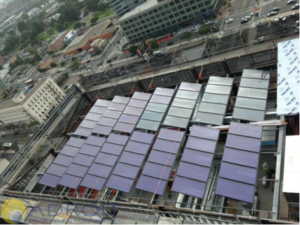California: Subsidy Programme off to a Slow Start
July 28, 2010
The Intersolar North America held in San Francisco in the middle of July was at the right time and place for analysing the first experiences with the new incentive programme in California called California Solar Initiative (CSI) Thermal Programme.
In several workshops, the CSI administrators talked about the slow start the programme has had since it was launched on 1 May. “State-wide, 26 applications were submitted and 114 installers have registered within the programme,” Katrina Phruksukarn said. She is programme manager at one of the four administrators, the California Center for Sustainable Energy. Another administrator is the Pacific Gas and Electric Company (PG&E), which was represented by Nick Stimmel: “We have received 10 residential applications, 6 of gas water heater users and 4 of electric water heater users. The average rebate was USD 1,300”. The total number of 26 applications include the figures of the last statement.
 Working at one of the administrators of the California Solar Initiative: Katrina Phruksukarn, Solar Water Heating Programme Manager at the California Center for Sustainable Energy (CCSE). Photo: Bärbel Epp
Working at one of the administrators of the California Solar Initiative: Katrina Phruksukarn, Solar Water Heating Programme Manager at the California Center for Sustainable Energy (CCSE). Photo: Bärbel Epp
Why was the programme off to such a slow start? Professionals from the sector, as well as the administrators named several major barriers for solar water heater systems in the sunny state of California:
- The most important barrier is motivating customer interest. 90 % of the households in California use natural gas to heat their hot water. Natural gas for water heating currently costs residential customers around USD 20 to 60 per month, depending on the number of persons in the household. This leads to long pay-back times for purchasing a solar water heater, which costs around 7,000 USD. The combination of the US 30% income tax credit and the new state rebate programme will significantly improve the value of solar water heaters.
- The second important barrier is the lack of access to information to the general public about the programme. In many cases, solar is seen as a synonym for photovoltaics, which California has been subsidizing for the last three years.
- Third: There are not enough solar and plumbing contractors experienced in installing solar water heating systems, because the solar water heater market in California has simply been asleep since 1985. To be eligible to offer the rebates, contractors have to take part in a one-day-workshop, which tells you all about, “how to apply for the subsidy, but not how to install a solar thermal system,” explains Phruksukarn. Such a preparation course seems hardly enough, which is why manufacturers and distributors are providing installation training and local schools have started to offer entry level training for the workforce.
- And last but not least, applying for the building permit is a challenging task. “There are 900 different building departments in California,” emphasizes Sue Kateley, Calseia Executive Director. “The permitting requirements vary and not all of the local departments publish their requirements online, so you have to go there personally to find out what is required”. Kateley pointed out that local permit fees should also impact the economics of solar water heating systems. A USD 1,000 permit fee for a USD 7,000 solar water heating system has proportionally a greater impact than a USD 1,000 permit fee on a USD 100,000 photovoltaic system.
- The commercial part of the programme did not start on 1 June as planned. “There are still some regulations to be discussed and we are hoping for a start next month,” announced Phruksukarn. One still unclear issue concerns the type of monitoring required for larger solar thermal systems.
 Worked for a solar contracting business that installed solar water heaters more than 30 years ago: Sue Kateley has been Executive Director of the California Solar Energy Industries Association (Calseia) since 2007. Prior to that position, she worked with the California Energy Commission for 20 years.
Worked for a solar contracting business that installed solar water heaters more than 30 years ago: Sue Kateley has been Executive Director of the California Solar Energy Industries Association (Calseia) since 2007. Prior to that position, she worked with the California Energy Commission for 20 years.
Photo: Bärbel Epp
But there are also some good options to overcome these barriers: The CSI includes a budget of USD 35 million for market facilitation efforts. This money will be spent on a marketing campaign for solar thermal technology and the incentive programme. “If we start rolling out the USD 35 million, we should see greater interest in solar water heating,” Kateley shows confidence. “We were the leader in this business”. In the early 1980ies, there were around 500 solar thermal companies, manufacturers, system suppliers and installers in the State of California. After the government stopped the tax credits at the end of 1984, this strong sector died. Now, it has to be rebuilt.
More information:
California Public Utilities Commission: http://www.cpuc.ca.gov
California Energy Commission: http://www.energy.ca.gov
California Solar Energy Industries Association (Calseia): http://www.calseia.org
California Solar Initiative: http://www.gosolarcalifornia.org


